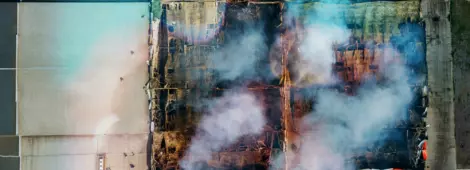
Fire Patterns + Trends During the Coronavirus Pandemic
by Prof. James Lygate
For several weeks now, many countries around the world have restricted movement and imposed various levels of lockdowns to limit the spread of COVID-19. As the global workforce has shifted from commercial and industrial spaces to either working or staying at home, some key fire trends have been uncovered.
Commercial vs. Domestic Fire Trends
Since late March, all non-essential workers have been sent home. Because most office buildings and factories have been left idle and unoccupied, there seems to be a modest fall in non-domestic fire calls. While this is an encouraging trend, it’s not the full story. Many fire service and rescue services have noted an increase in certain types of fires related to more people remaining at home in cramped conditions, often looking for activities to occupy their time.
As the weather improves in the Northern Hemisphere, many people will be looking to capitalize on any time spent outside. An increase in bonfires has been seen and can be attributed to homeowners using the enforced isolation to clean gardens, burn leaves and other general garden waste. The closure of many local authority waste disposal sites has left householders with little alternative then to burn garden waste. In recent days, we attended a forensic investigation where a large workshop was destroyed after a fire in a metal drum spread via overhanging trees. Sheds, garages and workshops are particularly vulnerable to this type of fire.
An increase has also been noted in fires involving barbeques — pointing to the warmer weather many of us are experiencing now. Unfortunately, these fires are still occurring on apartment balconies despite fatal incidents occurring over the past year and repeated warnings from fire authorities in the US, Canada and UK to not use a barbeque on a balcony. The combination of timber decking, timber facades and plastic “garden” furniture has the potential to be lethal. Barbeques have also been connected to wildfires occurring in open land, as people ignore isolation rules and cause severe damage to our natural open areas.
Electrical Fires in the Home
The enforced isolation has meant that entire families are now largely confined to buildings of differing sizes which can result in a heavier reliance on electrical equipment. TV’s, computers and video game consoles are all on overdrive now with the potential for electrical overloads and the use of seldom used and dated extension cables and adaptors increase the risk of fire. We’re also seeing an increased risk from already recognized hazards such as laptops being used on beds or cushions and the use of unfamiliar power tools. And whether we like it or not, our time at home also means we’re using kitchen appliances more to cook our meals, which is the most common cause of domestic fires.
The Impact on Fire Services
The coronavirus pandemic has also deeply affected our public services and fire authorities. In the UK, around 12-15% of firefighters are currently in isolation and unable to work. And across the US and Canada, many firefighters are at heightened risk of contracting the virus. Others have volunteered to assist the ambulance services by driving ambulances, and some have joined the Pandemic Multiagency Response Teams (PMART) to assist with overall pandemic response. The decreased bandwidth affects the ability of fire authorities to maintain existing attendance times.
Fire authorities have largely cancelled non-emergency related visits to homes, where they would normally give fire safety advice. They have also significantly reduced protection visits to give advice to businesses on fire safety matters. Though fire services have issued notes for a range of risks, the lack of face-to-face visits, particularly to the vulnerable, does have the potential to increase the risks from fire.
It’s important to understand the subtle trends the coronavirus pandemic is driving in fire safety across the world. Reductions in commercial and industrial fires can be converted to increases in the domestic setting. The forensic investigation of fire scenes is as important as ever and is still possible in most cases.












